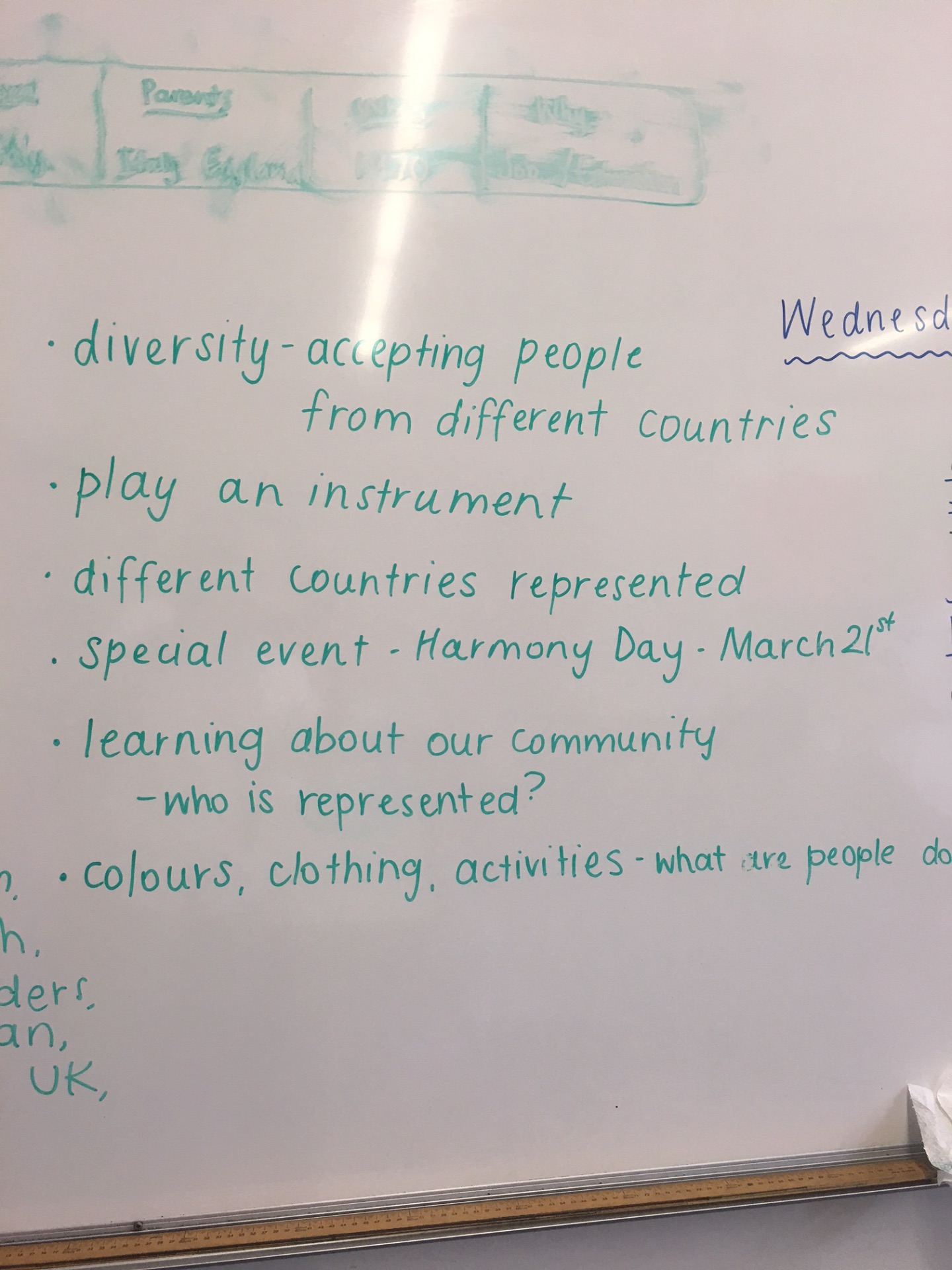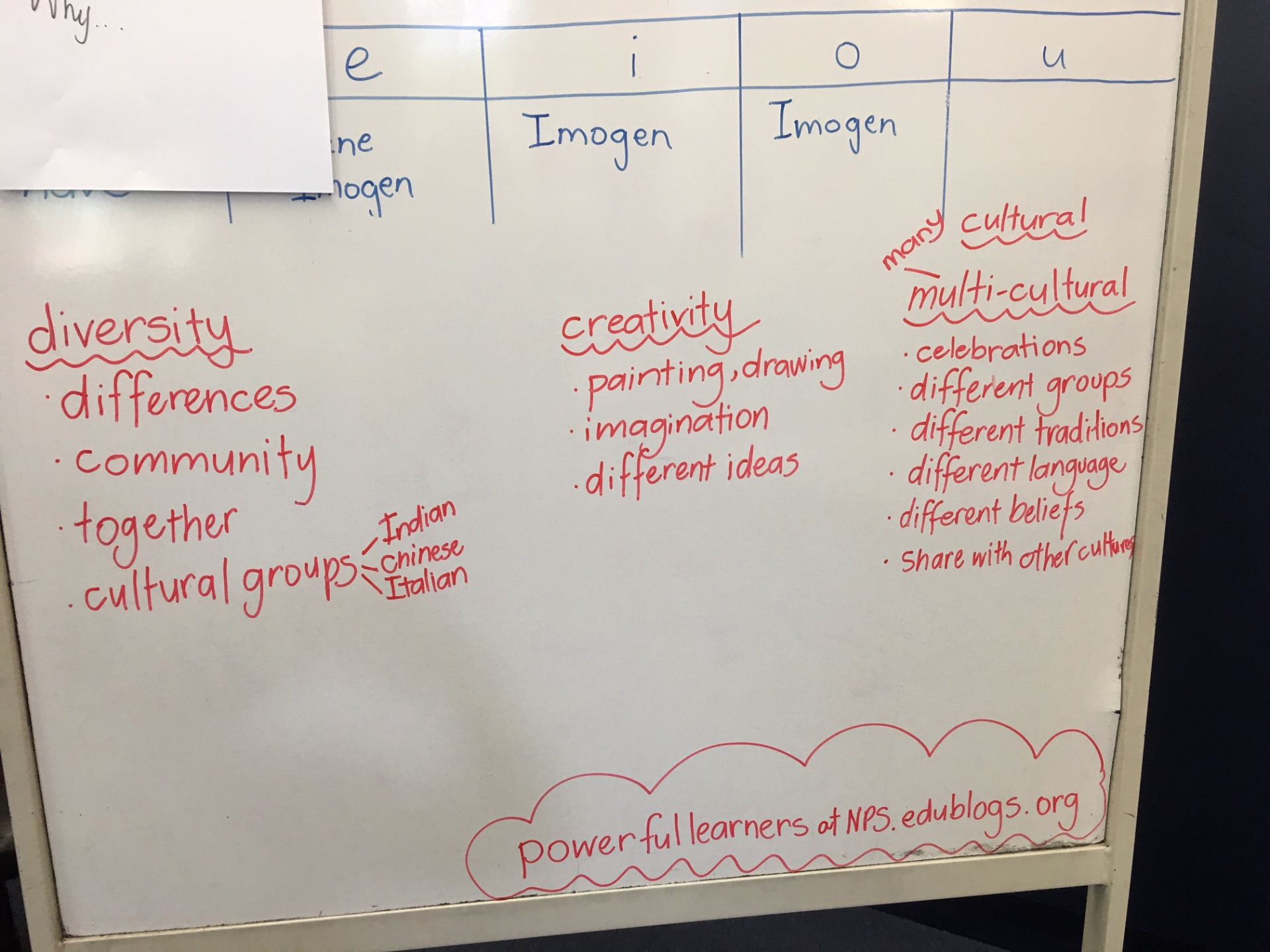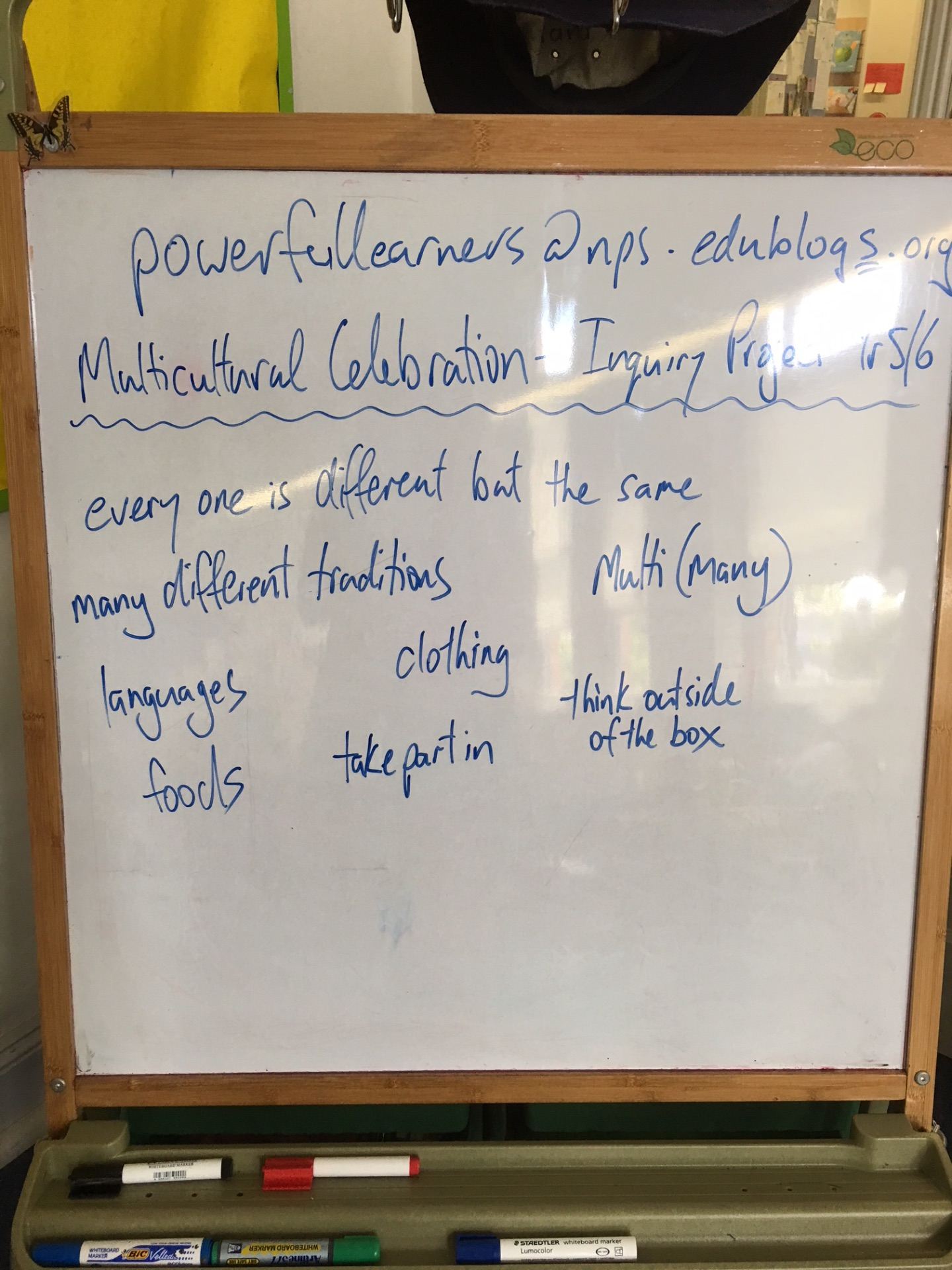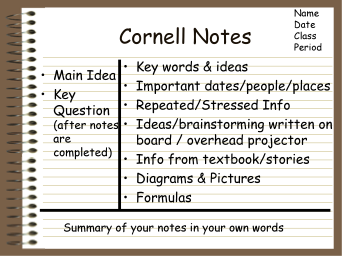There are 3 main groups of migration (family, skilled and humanitarian). 67% of migrants are skilled and looking for jobs. The criteria needed is to have English ability, qualifications and work experience. For people to get into family stream, migrants must have close family in Australia already. There is no type of test to get into Australia if a migrant is coming because of family. Humanitarian program helps refugees in need of a safe place to live. 3 reasons why this program is needed is because of war, famine or persecution. This program protects refugees in and out of Australia. In 2008-2009, 13,507 people were helped in Australia and 11,010 people were helped in their own country.
Category Archives: Room 13
Multicultural Celebration – Selecting
Look at the way adults take notes. What features do you notice that all of these have in common?

A diverse community creates opportunities for each other.
Friends
Differences
Learn from each other
Language
Team work
Community – family – local, global
Different thinking and ideas
Together
Culture
Race
Beliefs
Festival
All cultures – in our community, beliefs
Flags and maps – Australia
Clothes, costumes
Play
Lucky
Inclusive
Dancing
Story telling – legends
Music
Languages – hello, good morning
Use the Cornell Note Taking system to select appropriate key words and phrases (no sentences)
Multicultural Celebration – Locating
Year 5 Resources
Explore who has come to Australia in the past and why. (Before Federation)
http://differencedifferently.edu.au/one_country_many_cultures/part_3a.php
Year 6 Resources
Explore immigration to Australia since Federation
http://www.naa.gov.au/collection/snapshots/find-of-the-month/2007-july.aspx
Explore migration after the war
http://www.nma.gov.au/interactives/tlf/homes/index.html
Government Policies
https://www.homeaffairs.gov.au/about/corporate/information/fact-sheets
Australia’s migration program:
https://www.homeaffairs.gov.au/about/corporate/information/fact-sheets/01backgd
Changes in policy
https://www.homeaffairs.gov.au/about/corporate/information/fact-sheets/08abolition
Multicultural Celebration – Defining
Questions
| Who |
Who is in the audience? Who is in Norwood Primary School? Who am I? Who will we talk about when we share our culture? Who will be our main audience? Who are our resources? Who has a diverse culture? Who discovered the different cultures traditional flags? and why? Who created the Multicultural Festival? (in Adelaide) Who will be participating in the activities? Who will be viewing the events? |
| Where |
Where do you come from? Where is everybody from? Where are your ancestors from? Where do the different cultures come from? Where will we perform? Where will we get our information from? Where are we doing it? Where did the patterns of the flags originate from? Where were people born in the Norwood community? Where do cultures meet? Where do we do it? Where are we setting up? Where in the school will the stalls be? Where are your parents from? Where were you born? Where would we run this event? Where are the people in our community from? Where will the event be set? |
| What |
What are your traditions? What country are you from? What happened to my ancestors and where are they from? What culture are you? What is your cultural background? What country does everyone come from in our school? What will we present? What cultures are common in our community? What will our audience think? What country will we base it on? What other types of cultures do we have in our community? What differences are there in other cultures in comparison to Australia? What type of foods and traditions are there in different cultures? What are the cultures national foods? What religious beliefs do cultures have? What is the national clothing of the country? What is the biggest culture? What do different cultures do for fun? What time was the festival held? What would we do? What is your background? What percentage of each culture is represented in the Norwood community? What are some traditions from different cultures? What type of research are we going to do? What different foods do people eat around the world? What different clothes do people wear? What responsibilities do different people/ genders have? What things will be in the event? |
| How |
How did you arrive in Australia? How long did it take to get to Australia? How were the countries named? How will the event turn out? How were some cultures introduced to our community? How will we present it? How will we be organised? How long will it take? How will we represent ourselves? How many people are going to this event? How do the different languages come to be? How many different foods are there for each culture? How many cultures do we have in our Norwood community? How do cultures make their food? How do different cultures work in school? How many people in the largest culture? How many cultures are in the school and what are they? How to speak different languages? How many cultures are there in Norwood? How would you find out what culture everyone is? How do people dance? How will we make everyone feel welcome? How much money are we aiming to raise? |
| Why |
Why did you come to Australia? Why were cultures invented? Why do we have different cultures? Why did they come? Why do we think people came to Australia? Why will we perform? Why are there so many cultures? Why do all the cultures have different traditions? Why are we doing this event? Why do we have so many cultures in our community? Why are the cultures important? Why did people create the multicultural festival? Why do people eat different foods? Why are people treated differently? Why did all the countries separate? Why doesn’t everyone believe in different countries coming together? Why did Australia let people of other cultures in? Why are cultures so different from each other? Why do people come here? Why do people eat certain foods? |
| When |
When did you come here? When does the event start? When did the cultures come to Australia? When was the multicultural festival created? When does the different treatment stop? (attitudes) When did Australia start letting in foreigners? When did our community come together as a whole? When will the event be held? |
| Which |
Which cultures have the most influence on our community? Which parts of the world did they come from? Which different places have people come from? Which country has the most population? |
|
Do some countries have the same cultures as other countries? Does every country have some kind of icon? Could the visitors participate in a quiz? Would it be helpful to have fact sheets for each culture? Can we have class mates (if willing) to present cultural heritages? Will we need props? |
Countries of Birth of Students – Year 5/6
| Country | Class 1 | Class 2 | Class 3 | Class 4 | Total |
| Australia | 17 | 13 | 16 | 17 | 63 |
| Germany | 1 | 1 | |||
| New Zealand | 1 | 1 | 2 | ||
| Saudi Arabia | 1 | 1 | 2 | ||
| Sri Lanka | 1 | 1 | 1 | 3 | |
| India | 1 | 2 | 1 | 2 | 6 |
| Philippines | 1 | 1 | |||
| South Korea | 1 | 1 | |||
| Malaysia | 1 | 1 | 2 | ||
| Scotland | 1 | 1 | |||
| America | 1 | 1 | 2 | ||
| England | 1 | 1 | |||
| Hong Kong | 1 | 1 | |||
| Japan | 1 | 1 | |||
| Iran | 1 | 1 | |||
| United Arab Emirates | 1 | 1 | 2 | ||
| Turkey | 1 | 1 | |||
| Colombia | 1 | 1 | |||
| Taiwan | 1 | 1 | |||
| China | 2 | 2 |
Countries of Birth of Parents of Students – Year 5/6
| Country | Class 1 | Class 2 | Class 3 | Class 4 | Total |
| Australia | 25 | 23 | 26 | 18 | 92 |
| Germany | 1 | 1 | 2 | ||
| New Zealand | 3 | 1 | 2 | 6 | |
| Saudi Arabia | |||||
| Sri Lanka | 2 | 2 | 2 | 6 | |
| India | 2 | 5 | 4 | 5 | 16 |
| Philippines | 2 | ||||
| South Korea | |||||
| Malaysia | |||||
| Scotland | 2 | 2 | |||
| America | 2 | 1 | 2 | 5 | |
| England | 1 | 3 | 1 | 4 | 9 |
| Hong Kong | 2 | 2 | |||
| Japan | 1 | 2 | 3 | ||
| Iran | 2 | 1 | 3 | ||
| Poland | 1 | 2 | 3 | ||
| Vietnam | 2 | 2 | |||
| Spain | 1 | 1 | |||
| South Africa | 1 | 1 | 2 | ||
| Pakistan | 2 | 2 | 4 | ||
| Indonesia | 1 | 1 | |||
| Austria | 1 | 1 | |||
| Romania | 1 | 1 | |||
| Greece | 1 | 1 | 1 | 3 | |
| Malaysia | 1 | 1 | 2 | ||
| Singapore | 1 | 1 | |||
| Maldives | 2 | 2 | |||
| Iraq | 2 | 2 | |||
| Colombia | 2 | 2 | |||
| Taiwan | 1 | 1 | |||
| China | 4 | 4 | |||
| Turkey | 1 | 1 | |||
| Serbia | 1 | 1 | |||
| Mauritius | 1 | 1 | |||
| Cambodia | 1 | 1 | |||
| Ireland | 1 | 1 | |||
| Italy | 1 | 1 |
Multicultural Celebration – A Collaborative Inquiry Project – Year 5 and 6 – 2018
In Week 8 we plan to hold a Multicultural Celebratory Event to celebrate the diversity of our community. The Year 5/6 students will lead our community event with the aim to involve as many people in our community as possible – adults and students in fun, active, informative, engaging cultural activities. (Dancing, food demonstrations, listening to story telling, puppet shows, sports/ games, music, demonstrations, etc.)
Your challenge is to research cultural practices/ traditions/ activities that could be part of our Multicultural event. You will then, in small groups, need to plan, design, and lead small groups of participants in your activity. How will you engage/ inform/ entertain your audience/ participants?
Aim to highlight/ enact our school values of: Community, Diversity, Opportunity and Creativity.
https://www.flickr.com/photos/multiculturalsa/sets/
https://www.flickr.com/photos/multiculturalsa/sets/72157690002758395
DEFINE:
What do we already know?
Community – Cultural – multi-cultural
Diversity
Creativity
Opportunity
What would we like to find out?
Pose questions to guide inquiry
Which resources will be useful?
Homework:
Share ideas with family
Ask how they might support this school project.
United Nations Declaration on the Rights of Indigenous Peoples – Year 6 Geography
Geography – Year 6 – Indigenous Peoples of the World
Can you answer the questions:
1. What is a declaration?
2. Who are indigenous peoples?
3. What is the United Nations?
Little Lunch – Things to do to
| Stage | Purpose | Frame | Props | Script |
| 1 |
Introduction Who is your main character and how do we get to know them? |
Background – where? Close up Wide shot |
||
| 2 |
Something happens How did it all start? |
|||
| 3 | How does it become a tricky situation? | |||
| 4 | The Climax – What is the turning point of your story? | |||
| 5 | The End – Do things sort themselves out or does it just end in a big mess? |
Little Lunch – Characteristics: notes from Episode 24
Characters:
build suspense
over-dramatise
action –
- facial expressions
- talk
- dialogue
- monlogue
- walk
- emphasised
- hand movements
dress
props
- muesli bar
- basketball
- handball
- handcuffs
- cheese stick
- chalk
braces
normal school yard behaviour in background
“No Chill” -all emotion and …
Suspicion
Melanie – emotional & upset about where she had come from…
Batty was daydreaming: “gentle, creative daydreamer”
Atticus: “sweet,nerdy and always hungry”
Debra-Jo: “smart, ambitious,organised”
Melanie: “stubborn, courageous and a bit shy”
Rory: “naughty,distracted and very likeable”
Characters + key words
Setting
school
- playground
- brick buildings
- toilets
- library
- classroom
- office
- tree (monologue)
abstract setting and props eg, handcuffs
Storyline:
twins leave school mysteriously
short trivial stories
Max and Elsa went to dentist
Problem + explanation + solution through Debra-Jo’s telling of the story to Melanie
One liners that fit in with detective story:”Take this to the lab.”
“Why won’t you talk?” “What are you hiding?”
Connections:
It’s obvious that they didn’t kill each other, although suspense develops. (It’s obvious because the audience is ‘Kids’.)
Structure:
music
sound effects
- clapping
- bell
background activity – play
humour
Introduced problem
Mystery builds
Twist at end
Resolution
1st person
3rd person
Police show one liners
Little Lunch
Competition Winners
https://vimeo.com/channels/1079363/175794301
Episodes
Little Lunch – Episode 26 from Bob Franklin on Vimeo.




